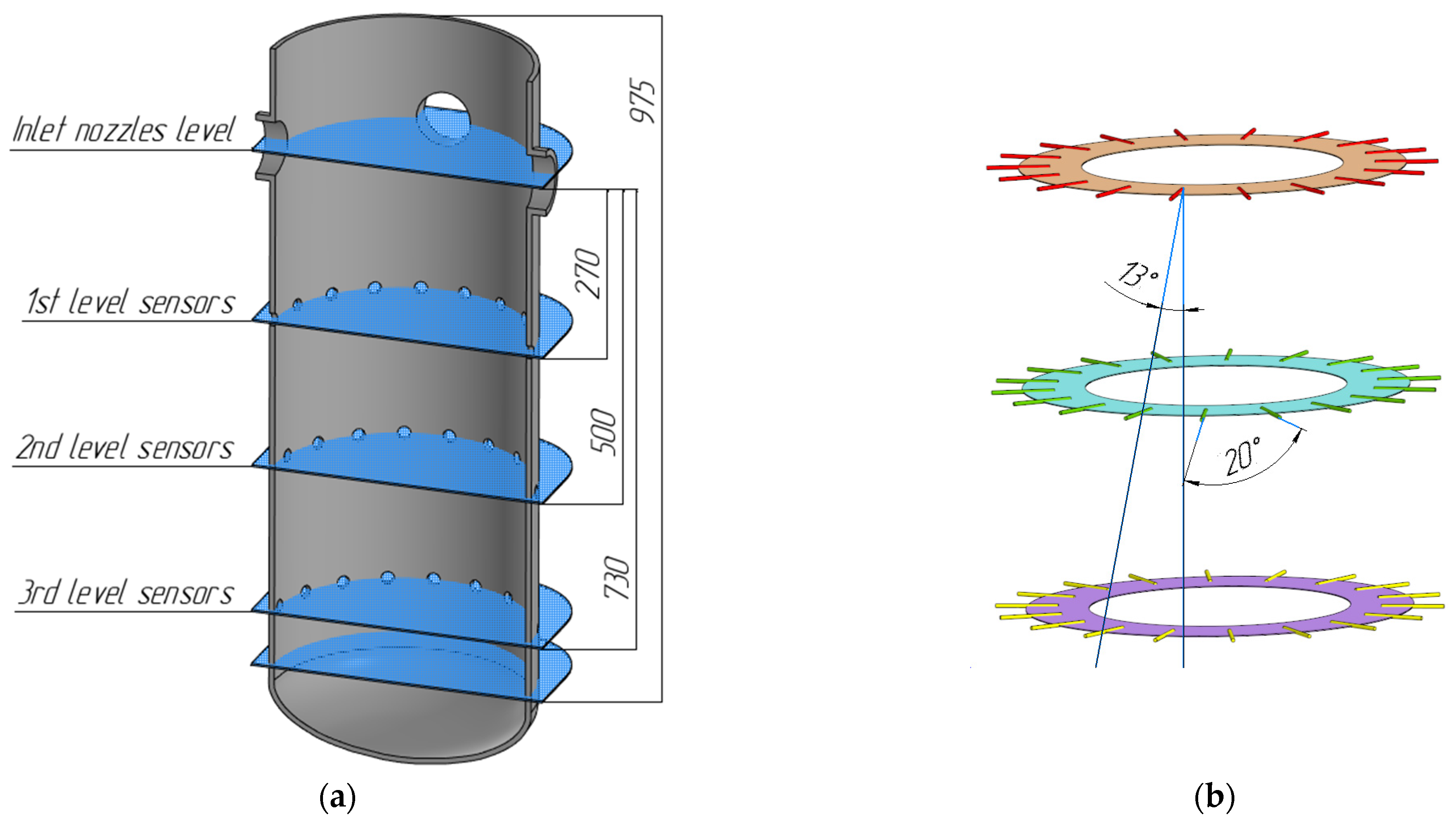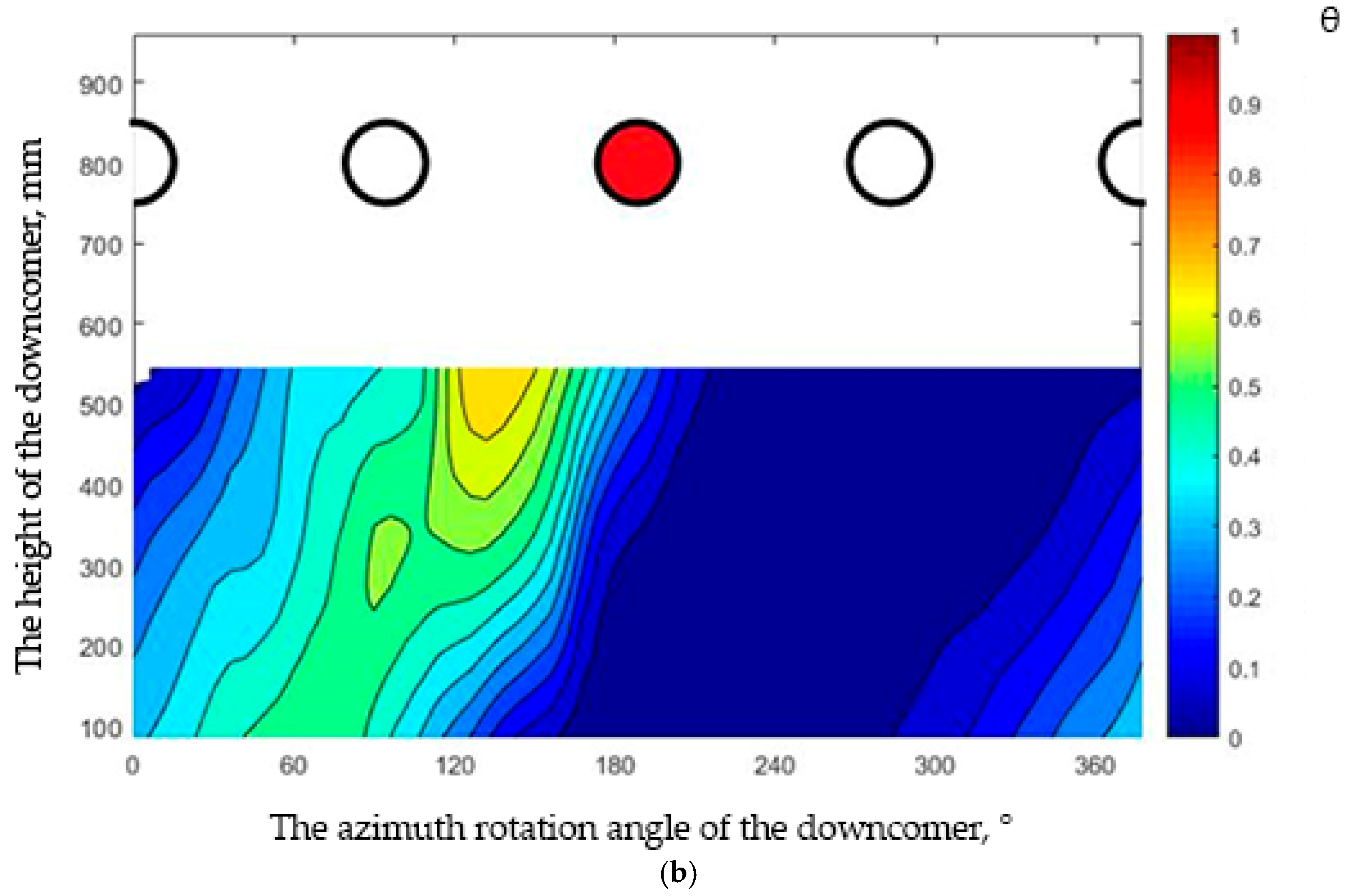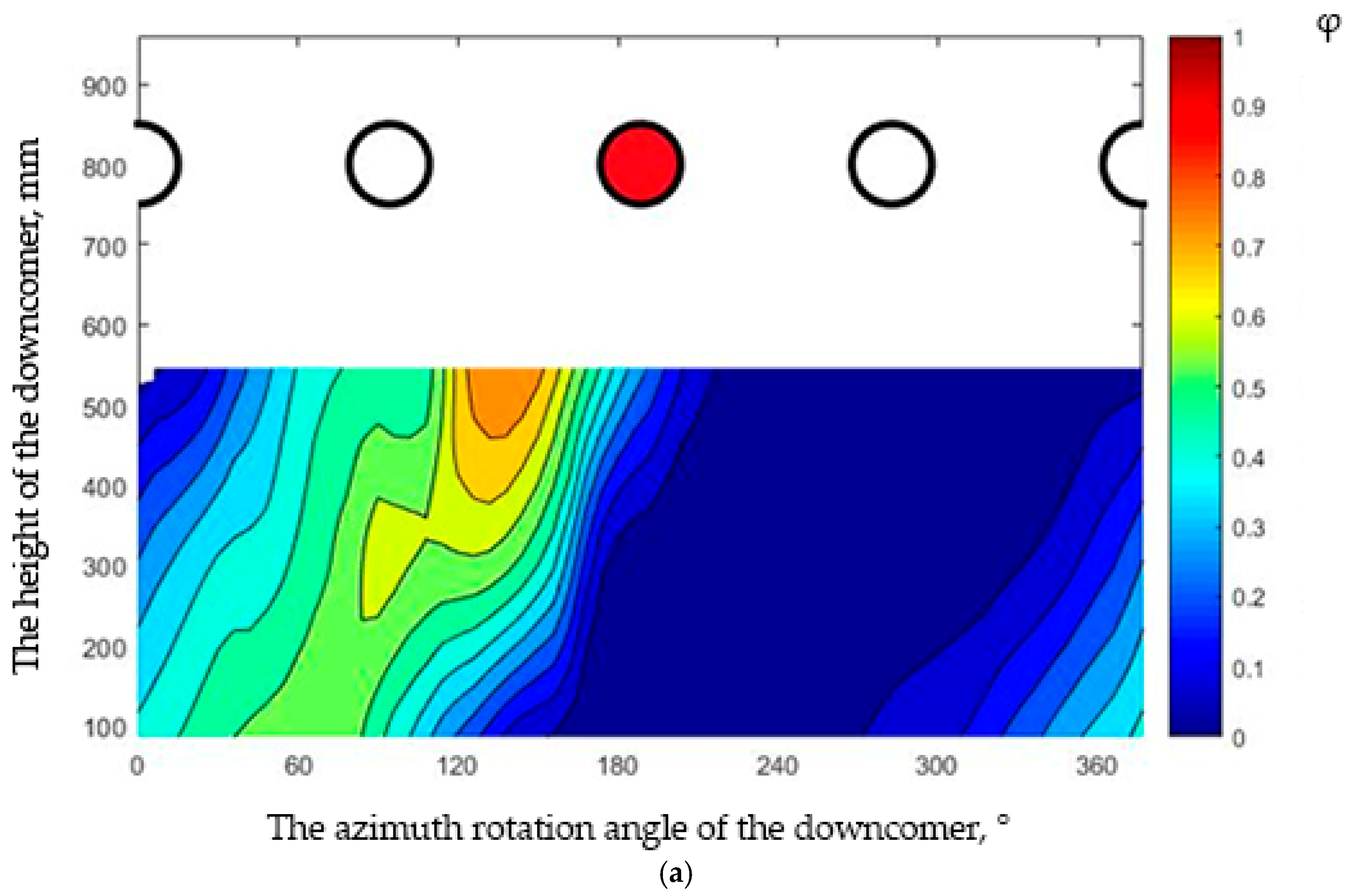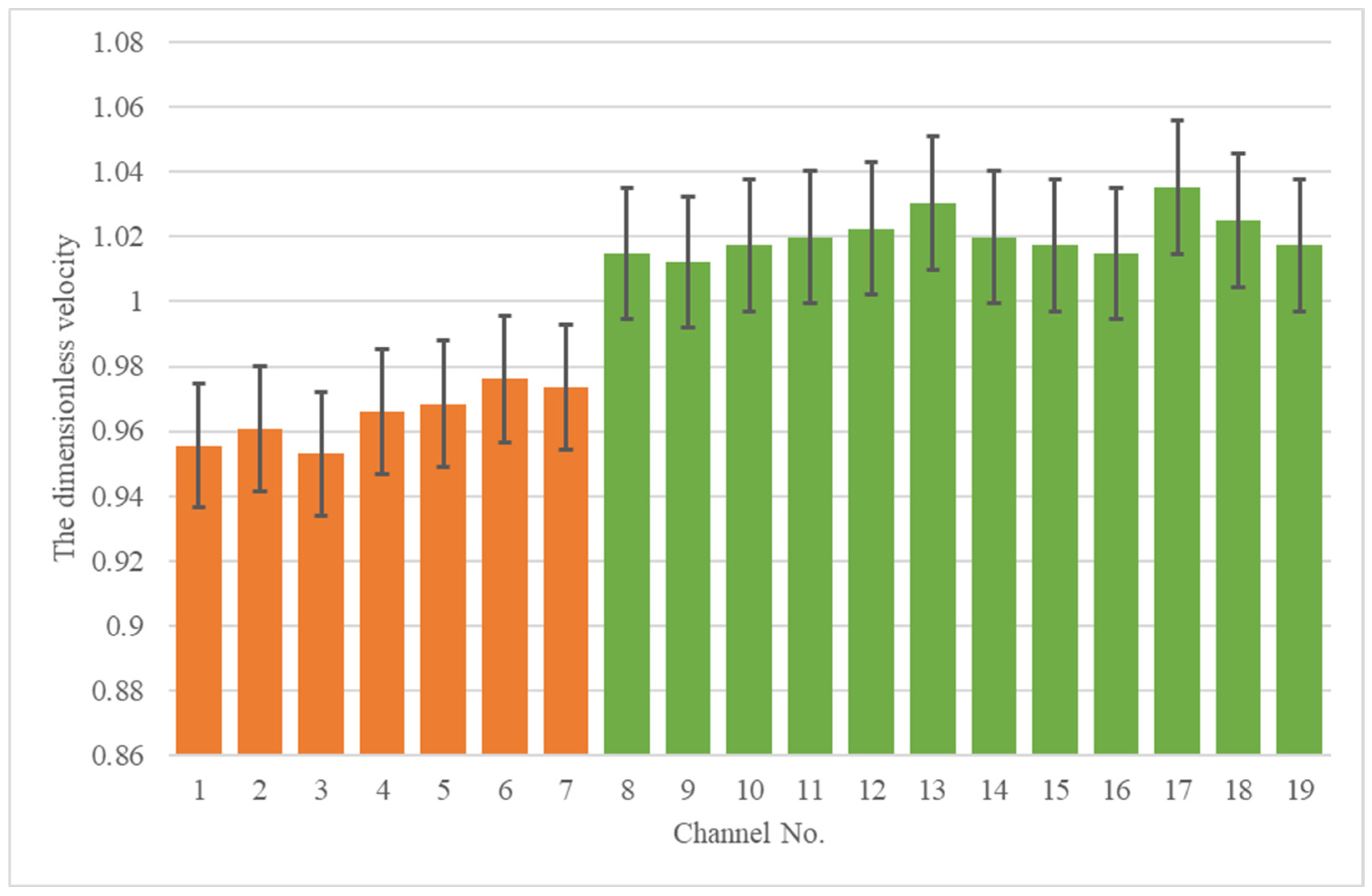Applicability of Reynolds Analogy and Visualization of Coolant Flow Mixing in Downcomer of Land-Based Water-Cooled SMR
Abstract
1. Introduction
2. Experimental Setup
2.1. Aerodynamic Test Facility
- High-Pressure Centrifugal Fan: Provides the motive force for the airflow.
- Surge Tank: Dampens flow pulsations and ensures stable inlet conditions.
- Flow Distribution System: A system of geometrically identical pipelines branching from the surge tank outlet; inner diameter is 100 mm.
- Test Section: Includes the scaled reactor pressure vessel test model.
- Instrumentation and Data Acquisition System: Measures flow parameters.
2.2. Scaled Annular Downcomer Test Model
- Inlet Configuration: Four radial nozzles positioned at 90° intervals with inner diameters of 100 mm.
- Annular Downcomer: Outer\inner diameters of 400\270 mm.
- Bottom Chamber: Formed by an elliptical bottom head and the lower core support structure.
- Core Simulator: Consists of 19 vertical flow channels. Calibrated orifices installed at the inlet of each channel provide precise hydraulic resistance, simulating the pressure drop characteristics of a reactor core.
- Upper Outlet Chamber: Collects flow exiting the core channels.
3. Methodologies and Devices
3.1. Isothermal Tracer Gas Method (Case 1)
- Indicator feed: Controlled by a precision flow meter Bronkhorst El-Flow F-201CV with an accuracy of ±0.5% of readings.
- Concentration measurement: Non-dispersive infrared gas analyzers ADK-03P. The system was calibrated using certified reference mixtures; measurement error: <±15 ppm by volume.
- Maximum tracer concentration ≤ 0.15% vol (1500 ppm). Tracer-to-main-flow ratio ≤ 0.05 (5 L/s tracer and 0.1 m3/s main flow per circuit), ensuring negligible impact on flow hydrodynamics (density change < 0.1%).
3.2. Non-Isothermal Heat Tracer Method (Case 2)
- Heating and low control: Precision flowmeter (accuracy: ±0.5%) and electrical heaters.
- Temperature measurement: Type K thermocouples with a diameter of 0.5 mm and NTC 2K thermistors. These devices were individually calibrated to an accuracy of ±0.2 °C using the temperature calibrator ELEMER-KT-650K. During the experiment, data were collected using a digital multimeter A34980 from Keysight Technologies. This device uses a thermal insulation and compensation design to provide precise temperature control for high-resolution scanning probe microscopy.
3.3. Sensor Locations
3.4. Velocity Field Characterization
3.5. Test Matrix and Operating Conditions
- One isothermal tracer gas experiment (propane injection into one loop).
- One non-isothermal experiment (heating one loop to ΔT ≈ 40 °C, which represents the temperature difference between the cold and hot loops).
4. Representativeness of Experimental Studies
- -
- For the heat transfer:
- -
- For the mass transfer:
- Turbulent transport similarity:
- 2.
- Dominance of turbulent diffusion:
- 3.
- Negligible buoyancy effects:
5. Results
- -
- Swirling Motion: In all experimental conditions, a hot temperature spot and propane impurity were detected in the region opposite the injection point, confirming the presence of swirling flow during its passage through the annular downcomer. The downcomer’s geometry caused significant flow deflection, with angles ranging from ~120° at a Reynolds number of 20,000 to 170° to 180° at other Reynolds numbers. This deflection led to a helical motion of the coolant, as seen in contrast distribution charts (Figure 4 and Figure 5). All measurements were taken under steady-state conditions (fluctuations < 3%).
- -
- Contrast Jet Dynamics: The opening angle of the contrast jet ranged from 15° to 20°, highlighting the stability of flow redirection within the annular downcomer regardless of any influence from the type of admixture during the mixing process.
- -
- Toroidal Vortex Formation: A sudden change in direction at the outlet of the annular downcomer into the bottom chamber, which has a large volume geometry, triggered the formation of a toroidal vortex. This phenomenon is consistent with previous studies [22].
- -
- Axial Vortex Effect: The admixture dimensionless value maps (Figure 6) show a shift in the position of maximum concentration as the coolant moved from the outlet of the annular downcomer to the core-simulating channels. The angle of rotation of the contrasting spot in the bottom chamber, relative to the outlet of the annular downcomer, ranged from 50 to 60 degrees for all tested Reynolds numbers, regardless of the type of admixture used. This shift may have been caused by the formation of an additional axial vortex in the bottom chamber.
- -
- Non-uniform Mixing: Both propane and hot jet experiments demonstrated incomplete mixing of the contrast admixture. Significant variations in relative concentration were observed at the core channel inlets. For example, at Re = 30,000, the minimum relative concentration (0.05) occurred in channel 8, while channel 12 exhibited a peak concentration of 0.44.
- -
- Central Channels: The flow velocities in the seven central channels were consistently below the average across the cross-section.
- -
- Peripheral Channels: The flow velocities in the outer row exceeded the average cross-sectional value.
6. Conclusions
- (1)
- Flow Swirling and Mixing Dynamics
- -
- The annular downcomer area was dominated by swirling motion, with observed angles ranging from 120 degrees to 180 degrees under varying experimental conditions.
- -
- An additional 60° flow rotation was consistently induced in the bottom chamber, independent of the Reynolds number.
- -
- Convective turbulent transfer in the annular downcomer emerged as the primary driver of interloop mixing, underscoring the limited efficacy of mixing devices in the bottom chamber.
- (2)
- Dependence on Reynolds Number
- -
- Increasing the Reynolds number from 20,000 to 50,000 had a negligible impact on the key turbulent mixing parameters, such as the maximum and minimum relative concentrations and temperature, the contrast jet opening angle (between 15° and 20°), and the flow deflection in the bottom chamber.
- -
- However, there was some sensitivity in the swirling angle in the downcomer to the Reynolds number, particularly within the range between 20,000 and 30,000.
- (3)
- Validation of Isothermal Modeling ApproachThe remarkable coincidence of dimensionless concentration (isothermal) and temperature (non-isothermal) distributions provides strong experimental validation, as follows:
- -
- Isothermal tracer experiments with a passive scalar accurately simulated non-isothermal mixing for reactor hydrodynamics under conditions of a high Reynolds number (Re > 104) and weak buoyancy (Richardson number Ri < 0.1).
- -
- This equivalence demonstrates that turbulent scalar transfer (mass and heat) is governed by a single dominant mechanism in these flows.
- -
- Differences in molecular diffusion processes are compensated for by the similarity in turbulent transport, confirming that Scturb = Prturb holds under the specified conditions.
- (4)
- Method LimitationsThe Reynolds analogy (Scturb = Prturb) breaks down
- -
- Where molecular transfer dominates if the molecular Prandtl number differs significantly from the molecular Schmidt number.
- -
- In flows with strong buoyancy effects (Ri > 0.1) where stratification distorts the turbulent structure.
- (5)
- Project Design Changes
- -
- To optimize coolant mixing in SMR designs that require a uniform flow property distribution, additional mixing devices should be placed in the annular downcomer rather than in the bottom chamber of the pressure vessel.
- (6)
- Further Research Directions
- -
- The consistency of mixing characteristics across the tested Re range suggests findings may be scalable; however, validation at significantly higher Reynolds numbers is required.
- -
- Detailed characterization of the velocity field, particularly within the downcomer, is essential. To this end, an optically transparent experimental model of the pressure vessel is currently under development for future LDV studies.
- -
- The experimental dataset generated in this study—detailing velocity, concentration, and temperature fields under controlled high-Re and low-Ri conditions—provides a benchmark for validating CFD codes applied to coolant mixing in SMR downcomer geometries.
Author Contributions
Funding
Institutional Review Board Statement
Informed Consent Statement
Data Availability Statement
Conflicts of Interest
Abbreviations
| CFD | Computational Fluid Dynamics |
| LDV | Laser Doppler Velocimetry |
| NNSTU | Nizhniy Novgorod State Technical University |
| ROCOM | Rosendorf Coolant Mixing Model |
| SMR | Small Modular Reactor |
References
- Petrunin, V.V.; Sheshina, N.V.; Fateev, S.A.; Kurachenkov, A.V.; Shchekin, D.V.; Brykalov, S.M.; Bezrukov, A.A. Scientific and technical aspects of developing a RITM-200N innovative reactor for SNPPs. At. Energy 2023, 134, 1–10. [Google Scholar] [CrossRef]
- Rohde, U.; Kliem, S.; Hohne, T.; Karlsson, R.; Hemstrom, B.; Lillington, J.; Toppila, T.; Elter, J.; Bezrukov, Y. Fluid mixing and flow distribution in the reactor circuit, measurement data base. Nucl. Eng. Des. 2005, 235, 421–443. [Google Scholar] [CrossRef]
- Bieder, U.; Fauchet, G.; Betin, S.; Kolev, N.; Popov, D. Simulation of mixing effects in a VVER-1000 reactor. Nucl. Eng. Des. 2007, 237, 1718–1728. [Google Scholar] [CrossRef]
- Kleim, S.; Suhnel, T.; Rohde, U.; Hohne, T.; Prasser, H.-M.; Weiss, F.-P. Experiments at the mixing test facility ROCOM for benchmarking of CFD codes. Nucl. Eng. Des. 2008, 238, 566–576. [Google Scholar] [CrossRef]
- Suikkanen, H.; Telkkä, J.; Räsänen, A.; Kotro, E.; Böttcher, M.; Rueda-Villegas, L.; Sunkova, V. SMR core thermal hydraulic experiments and code validation with the MOTEL test facility. Nucl. Eng. Des. 2025, 439, 114056. [Google Scholar] [CrossRef]
- Prasser, H.-M.; Kliem, S. Coolant mixing experiments in the upper plenum of the ROCOM test facility. Nucl. Eng. Des. 2014, 276, 30–42. [Google Scholar] [CrossRef]
- Truong, T.; Suikkanen, H.; Hyvärinen, J. Reactor Core Conceptual Design for a Scalable Heating Experimental Reactor, LUTHER. J. Nucl. Eng. 2021, 2, 207–214. [Google Scholar] [CrossRef]
- Sanchez-Espinoza, V.H.; Gabriel, S.; Suikkanen, H.; Telkkä, J.; Valtavirta, V.; Bencik, M.; Kliem, S.; Queral, C.; Farda, A.; Abéguilé, F.; et al. The H2020 McSAFER project: Main goals, technical work program, and status. Energies 2021, 14, 6348. [Google Scholar] [CrossRef]
- Hu, P.; Chen, G.; Tian, Z.; Kang, H.; Jin, Y. Appah Investigating on multi-RANS models coupling simulation for flow mixing experiments. Ann. Nucl. Energy 2020, 142, 107389. [Google Scholar] [CrossRef]
- Kim, Y.I.; Bae, Y.; Chung, Y.J.; Kim, K.K. CFD simulation for thermal mixing of a SMART flow mixing header assembly. Ann. Nucl. Energy 2015, 85, 357–370. [Google Scholar] [CrossRef]
- Farkas, I.; Hutli, E.; Farkas, T.; Takács, A.; Guba, A.; Tóth, I. Validation of computational fluid dynamics calculation using Rossendorf coolant mixing model flow measurements in primary loop of coolant in a pressurized water reactor model. Nucl. Eng. Technol. 2016, 48, 941–951. [Google Scholar] [CrossRef]
- Heib, C.; Swiecicki, L.; Glantz, T.; Freitas, R. Validation of ANSYS CFX code on ROCOM tests performed in the framework of the OECD PKL2 project. In Proceedings of the 15th International Topical Meeting on Nuclear Reactor Thermalhydraulics (NURETH-15), Pisa, Italy, 12–17 May 2013. [Google Scholar]
- Höhne, T.; Kliem, S. Rohde Buoyancy-driven mixing studies of natural circulation flows using rossendorf coolant mixing model experiments and CFD. Chem. Ing. Tech. 2011, 83, 1282–1289. [Google Scholar] [CrossRef]
- Li, J.; Wang, M.; Fang, D.; Wang, J.; Liu, D.; Tian, W.; Qiu, S.; Su, G. CFD simulation on the transient process of coolant mixing phenomenon in reactor pressure vessel. Ann. Nucl. Energy 2021, 153, 108045. [Google Scholar] [CrossRef]
- Dmitriev, S.; Demkina, T.; Dobrov, A.; Doronkov, D.; Kuritsin, D.; Nikolaev, D.; Pronin, A.; Riazanov, A.; Solntsev, D. Modeling and Visualization of Coolant Flow in a Fuel Rod Bundle of a Small Modular Reactor. Fluids 2024, 9, 235. [Google Scholar] [CrossRef]
- Castellani, F.; Curzio, G.; Pieve, L.; Grazzini, R. Experimental tests on the applicability of a radioactive tracer technique for measuring coolant mixing in nuclear reactor fuel subassemblies. Nucl. Eng. Des. 1975, 32, 105–109. [Google Scholar] [CrossRef]
- Samoilov, O.B.; Shipov, D.L.; Kupriyanov, A.V.; Sholin, E.V.; Vishneva, T.Y.; Molodtsov, A.A.; Osin, A.B.; Dmitriev, S.M.; Khrobostov, A.E.; Doronkov, D.V.; et al. Efficiency studies of heat-transfer intensifier grids in TVSA-T model fuel assemblies. At. Energy 2020, 128, 17–23. [Google Scholar] [CrossRef]
- Yu, A. Snegirev, High-Performance Computing in Technical Physics. In Numerical Modeling of Turbulent Flows: Training Manual; Politekhnicheskii Universitet: St. Petersburg, Russia, 2009. [Google Scholar]
- Kays, W.M. Turbulent Prandtl number—Where are we? ASME J. Heat Transf. 1994, 116, 284–295. [Google Scholar] [CrossRef]
- Jørgensen, F.E. How to Measure Turbulence with Hot-Wire Anemometry; Dantec Dynamics: Skovlunde, Denmark, 2007. [Google Scholar]
- Monin, A.S.; Yaglom, A.M. Statistical Fluid Mechanics; MIT Press: Cambridge, MA, USA, 1971; Volume 1. [Google Scholar]
- Mitrofanova, O.V. Hydrodynamics and Heat and Mass Transfer of Swirling Flows in the Channels of Nuclear Power Facilities; Fizmatlit: Moscow, Russia, 2010. [Google Scholar]









| Characteristic | Reynolds Number | |||||
|---|---|---|---|---|---|---|
| 20,000 | 30,000 | 50,000 | ||||
| Admixture | Heat | Admixture | Heat | Admixture | Heat | |
| Flow rate through the experimental model of air, m3/s | 0.16 | 0.16 | 0.24 | 0.24 | 0.40 | 0.40 |
| Additional admixture flowrate, dm3/min | 2.0 | - | 3.0 | - | 5.0 | - |
| Flow rotation angle inside annular downcomer, deg | 120 | 120 | 180 | 180 | 180 | 180 |
| Flow rotation angle at the bottom chamber of the test model, deg | 60 | 60 | 60 | 60 | 60 | 60 |
| Maximum of relative admixture concentration/temperature at the entrance of the core simulator (channel number) | 0.44 (14) | 0.45 (14) | 0.44 (12) | 0.46 (12) | 0.47 (12) | 0.46 (12) |
| Minimum of relative admixture concentration/temperature at the entrance of the core simulator (channel number) | 0.08 (8) | 0.07 (8) | 0.05 (8) | 0.06 (8) | 0.05 (8) | 0.05 (8) |
Disclaimer/Publisher’s Note: The statements, opinions and data contained in all publications are solely those of the individual author(s) and contributor(s) and not of MDPI and/or the editor(s). MDPI and/or the editor(s) disclaim responsibility for any injury to people or property resulting from any ideas, methods, instructions or products referred to in the content. |
© 2025 by the authors. Licensee MDPI, Basel, Switzerland. This article is an open access article distributed under the terms and conditions of the Creative Commons Attribution (CC BY) license (https://creativecommons.org/licenses/by/4.0/).
Share and Cite
Riazanov, A.; Dmitriev, S.; Dobrov, A.; Doronkov, D.; Pronin, A.; Demkina, T.; Kuritsin, D.; Nikolaev, D.; Solntsev, D. Applicability of Reynolds Analogy and Visualization of Coolant Flow Mixing in Downcomer of Land-Based Water-Cooled SMR. Fluids 2025, 10, 244. https://doi.org/10.3390/fluids10090244
Riazanov A, Dmitriev S, Dobrov A, Doronkov D, Pronin A, Demkina T, Kuritsin D, Nikolaev D, Solntsev D. Applicability of Reynolds Analogy and Visualization of Coolant Flow Mixing in Downcomer of Land-Based Water-Cooled SMR. Fluids. 2025; 10(9):244. https://doi.org/10.3390/fluids10090244
Chicago/Turabian StyleRiazanov, Anton, Sergei Dmitriev, Aleksandr Dobrov, Denis Doronkov, Aleksey Pronin, Tatiana Demkina, Daniil Kuritsin, Danil Nikolaev, and Dmitriy Solntsev. 2025. "Applicability of Reynolds Analogy and Visualization of Coolant Flow Mixing in Downcomer of Land-Based Water-Cooled SMR" Fluids 10, no. 9: 244. https://doi.org/10.3390/fluids10090244
APA StyleRiazanov, A., Dmitriev, S., Dobrov, A., Doronkov, D., Pronin, A., Demkina, T., Kuritsin, D., Nikolaev, D., & Solntsev, D. (2025). Applicability of Reynolds Analogy and Visualization of Coolant Flow Mixing in Downcomer of Land-Based Water-Cooled SMR. Fluids, 10(9), 244. https://doi.org/10.3390/fluids10090244






